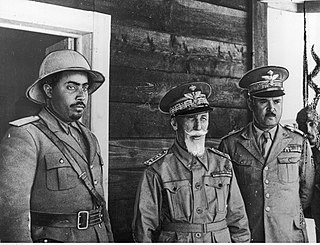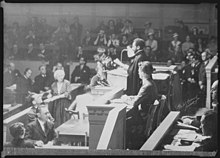
Haile Selassie I was the Emperor of Ethiopia from 1930 to 1974. He rose to power as the Regent Plenipotentiary of Ethiopia under Empress Zewditu between 1916 and 1930. Widely considered to be a defining figure in modern Ethiopian history, he is accorded divine importance in Rastafari, a relatively new Abrahamic religion that emerged in the Colony of Jamaica in the 1930s. A few years before he began his reign over the Ethiopian Empire, Selassie defeated Ethiopian army commander Ras Gugsa Welle Bitul, who was the nephew of Empress Taytu Betul, during the Battle of Anchem. He belonged to the Solomonic dynasty, which was founded by Emperor Yekuno Amlak in 1270; Amlak's successors claimed that he was a lineal descendant of Menelik I, the legendary Emperor of Ethiopia who was supposedly born to King Solomon and Queen Makeda of the Kingdom of Israel and the Kingdom of Sheba, respectively. Modern historians regard the Solomonic lineage claim as an unfounded myth created by Yekuno Amlak to justify wresting power from the Zagwe Dynasty.

Lorenzo Taezaz was an Ethiopian official in diplomatic affairs. He served as Emperor Haile Selassie's diplomatic representative during the Emperor's exile in Britain following the Second Italo-Ethiopian War, being the permanent delegate from Ethiopia to the League of Nations. After the restoration of the Ethiopian government, Lorenzo was Minister of Foreign Affairs, Minister of Posts and Telegraph, and served in the Ethiopian Senate.

The Anglo-Ethiopian Agreement was a joint effort between Ethiopia and the United Kingdom at reestablishing Ethiopian independent statehood following the ousting of Italian troops by combined British and Ethiopian forces in 1941 during the Second World War.

The Ethiopian Empire, historically known as Abyssinia or simply Ethiopia, was a sovereign state that encompassed the present-day territories of Ethiopia and Eritrea. It existed from the establishment of the Solomonic dynasty by Yekuno Amlak around 1270 until the 1974 coup d'état by the Derg, which ended the reign of the final Emperor, Haile Selassie. In the late 19th century, under Emperor Menelik II, the empire expanded significantly to the south, and in 1952, Eritrea was federated under Selassie's rule. Despite being surrounded by hostile forces throughout much of its history, the empire maintained a kingdom centered on its ancient Christian heritage.

The Army of the Ethiopian Empire was the principal land warfare force of the Ethiopian Empire and had naval and air force branches in the 20th century. The organization existed in multiple forms throughout the history of the Ethiopian Empire from its foundation in 1270 by Emperor Yekuno Amlak, to the overthrow of the monarchy and Emperor Haile Selassie in 1974 by members of the Ethiopian army. Due to the country's position along multiple trade routes and its maintenance of independence against multiple Islamic and colonialist invasions lead to multiple conflicts against numerous major countries including the Ottomans, Egyptians, British, and Italians.

The March of the Iron Will was an Italian offensive occurring from 26 April to 5 May 1936, during the final days of the Second Italo-Ethiopian War. Its goal was to capture the Ethiopian capital, Addis Ababa, in a show of force for Fascist propaganda. An Italian mechanized column under the command of Pietro Badoglio, Marshal of Italy, advanced from the town of Dessie to take Addis Ababa. The march covered a distance of approximately 200 miles (320 km).

Seyoum Mengesha KBE was an army commander and a member of the royal family of the Ethiopian Empire.

Haile Selassie Gugsa CBE (1907–1985) was an Ethiopian army commander and member of the Imperial family from Tigray. He is known for betraying his country during the Second Italo-Ethiopian War and becoming a fascist collaborator.
Getachew Abate (1895–1952) was an army commander and a member of the nobility of the Ethiopian Empire.
Hailu Tekle Haymanot, also named Hailu II of Gojjam, was an army commander and a member of the nobility of the Ethiopian Empire. He represented a provincial ruling elite who were often at odds with the Ethiopian central government. Hailu Tekle Haymanot was an independent-minded potentate who, throughout his life, was mistrustful of and mistrusted by the Emperor.
Ayalew Birru, or Ayyalaw Birru, was an Ethiopian army commander, a patriot, and a cousin of Emperor Haile Selassie I.
Adefrsew Yenadu (1873–1950) was an army commander, a member of the nobility of the Ethiopian Empire, and a patriot.
My Life and Ethiopia's Progress is the autobiography of Emperor of Ethiopia Haile Selassie I, written over the course of his life, and published in two volumes in 1973–74.

Germame Neway was an Ethiopian politician known for his role in 1960 Ethiopian coup d'état attempt. He was leader of the Wolayita province, and the Somali province. Germame was a member of the aristocracy of Shewa. He died by suicide on 24 December 1960.

Ethiopia–United Kingdom relations are the bilateral relations between Ethiopia and the United Kingdom. Currently, Ethiopia has an embassy in London and United Kingdom has an embassy in Addis Ababa. Historically, their relations traced over centuries covered a range of areas including, but not limited to, trade, culture, education and development cooperation. The UK is the first country to open its embassy in Addis Ababa. Ethiopia is the first African country to open an embassy in London.

This is chronological list about the Ethiopian Empire, an empire dominated the present-day Ethiopia and Eritrea from the beginning of establishment of Solomonic dynasty by Emperor Yekuno Amlak in 1270 to fall of monarchy on 21 March 1975 under Haile Selassie.

On 12 September 1974, Emperor Haile Selassie was deposed by the Coordinating Committee of the Armed Forces, Police, and Territorial Army, a Soviet-backed military junta that consequently ruled Ethiopia as the Derg until 28 May 1991.

The Ethiopian Revolution was a period of civil, police and military upheaval in Ethiopia to protest against the weakened Haile Selassie government. It is generally thought to have begun on 12 January 1974 when Ethiopian soldiers began a rebellion in Negele Borana, with the protests continuing into February 1974. People from different occupations, starting from junior army officers, students and teachers, and taxi drivers, joined a strike to demand human rights, social change, agrarian reforms, price controls, free schooling, and releasing political prisoners, and labor unions demanded a fixation of wages in accordance with price indexes, as well as pensions for workers, etc.

This is a chronology of the lifetime of Ethiopian Emperor Haile Selassie.

This is timeline of Harar, a city in eastern Ethiopia from the initial history to present.


















